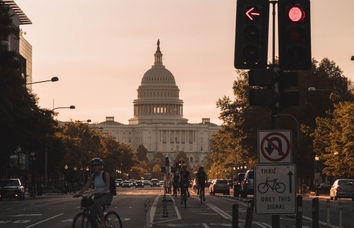
My Workstory: Earning $90,000 as an Airline First Officer

We’re back with another installment of My Workstory: VisualCV’s project to spotlight women from different backgrounds, industries, and environments, sharing exactly how they got to where they are today. Despite their variety of experiences, all of the women you’ll hear from throughout this series have one thing in common: they’re high-earners who’ve put in the work to climb the ranks and want to share advice for getting there too.
Quick Facts:
Name: R Age: Early 30s Location: The Rocky Mountain area of the US Job Title: First Officer Salary: $90,000
Would you say that you have a “cool job”? While we all aspire to have a job that we enjoy and find interesting, there are a few types of jobs that everyone else seems to find interesting, too. Whether you work for a major company people are interested in, your job is something people aspire to have, or it’s just plain interesting, some people are just destined for a lifetime of wide-eyed looks once they tell someone what they do for a living.
Today’s My Workstory subject, R, is very used to that! And, while she agrees that she has a “cool job,” R is also aware of the differences between the way she sees her job and the way others might view it. “It is a very strict job in several senses,” she explains. “There is very little room for creativity, free-thinking, or collaboration. I think this job attracts people who like consistency, and a more regimented type of job.”
“Additionally, I think the general public doesn’t realize how grueling this job can be,” She continues. “8 hours a day in an airplane being very sedentary, noisy hotels, time zone changes, lots of short nights add up to be very tiring. We are often at the mercy of the company, weather and maintenance delays cut into our layover times which is time for us to call family, get food, exercise, catch up on sleep. Crew scheduling can literally lose track of employees when there is a big meltdown. I’ve slept on an airplane with the rest of my crew and terminal floor another time when previous companies couldn’t keep up with cancellations and there were no hotels available for us during a nor’easter.”
Every job comes with its good and bad, so what does R view as some of the benefits to her career? “I know a lot of pilots enjoy the fact that when you’re at work, you’re there to work. We fly multiple legs per day (or one long international flight), go to the hotel, rinse and repeat for a set number of days. That means when we are on days off, we have zero obligations to work – no emails, no phone calls.”
The right to disconnect from work has been a hot-button topic in the wake of the pandemic’s rise to work-from-home arrangements. What began as a welcome break from the office quickly brought forward issues when employees felt as though they had no escape from work. In response, laws have been proposed – and, in some cases, enacted – to force companies to hold a written policy about their employees’ hours, prohibiting them from being contacted about work outside of those set times.
However, that’s not to say that R’s career has come without extra hours or sacrifice! “I’ve been thinking deeply about [how I see myself in relation to my job] the last few years,” she says. “I’ve sacrificed a lot of time and effort to get to my long-term airline. We miss a lot of life events because of the demands of this industry. I feel tremendously guilty that I’ve missed friends’ weddings and time with family, and ended romantic relationships because I put my job first.I feel like I spent my entire 20s grinding and living out of a suitcase, always on the road. Now in my 30s, I’m deliberately taking time to rekindle friendships and pursue hobbies that I didn’t have the ability to do in previous years.”

Any job, and every industry, comes with surprises. R’s often asked questions about her job; “People are very curious about this job and industry; I think it has been really glamorized and people often forget that it is a job that comes with a tremendous amount of responsibility to prioritize safety. Each trip we go on isn’t a vacation at an all-inclusive!”
“We don’t have ‘routes,’” she explains. “Our schedule changes month to month in terms of what days we fly and where we overnight. We typically work 15-17 days a month. We view our schedule as having ‘trips.’ They can be anywhere from a day trip (1 day) to 12 days long. It totally depends on your airline and the contract you work under. When we are at work, the company arranges for our transportation to and from the hotel, and pays for our hotel. Lastly, you don’t have to live where you are based: you can commute, but it’s solely done on your own time and by your own means. Usually you check open seats available on your airline to get a ride to work.”
While knowing the ins and outs of being a pilot is incredibly interesting to those not in the know, those fun facts actually weren’t what surprised R the most about her career. She’s found herself surprised – and disappointed – in the Federal Aviation Administration (FAA)’s policies surrounding mental health support for pilots. “For the most part, we all love our jobs and want to provide the best experience for passengers,” R says. “(but) we still deal with normal life events and need better, easier access to mental health care and support. Many pilots fear this [seeking mental health assistance] process, understandably so. From my perspective, these circumstances lead to a lot of alcohol abuse and denial/avoidance about any possible problems. It is a scary feeling [that] we are one medical event away from possibly losing our entire career and having very few transferable skills to start over with.”
Current FAA policy provides pilots the option to take personal leave, engage in therapy, and/or take one of 5 approved medications if deemed absolutely necessary. However, pilots must provide a medical certificate in order to take medication, and the process is many stages long and can take up to a year or more – unpaid. “Living out of a suitcase half the month, in a new hotel each night, being subject to weather and maintenance delays, schedule changes, airline IT meltdowns, working with new crews each day, while missing anniversaries, birthdays, family events and holidays can be really hard at times,” R shares.
Does R believe her career is worth it, even despite all its challenges? “For me personally, it is a better fit than a traditional Monday-Friday 9-5 job. So I feel like I made the right choice for my long-term profession.”
R’s Workstory

Between 2011 and 2014, R worked part time restaurant and retail jobs on her college campus while studying full-time. “My plan was to work part-time throughout college and take advantage of staying summer semesters to work and knock out a few classes in order to graduate within 4 years,” R explains. “I held several part-time jobs over the course of a few years in order to meet the demands of my class schedule for that specific semester. I worked lots of nights and weekends. I was not able to work one semester due to (a) high course load, but my plan worked out for the most part.”
During her college years, R also worked as a Certified Flight Instructor (CFI). From 2013-2015, she worked part-time, and then full-time at her university, teaching students how to fly small single- and multi-engine aircraft. “Pilots are required a specific number of total flight hours before they are employable at an airline. In my case it was 1,000 hours. Working as a CFI was the fastest way to build my flight time.”
In 2015, R took her first step into becoming an airline pilot. She worked for Airline #1, a regional passenger airline. Over the course of 5 years, she worked her way up from First Officer to Captain, while also holding several roles within her union.
A unique element of working as a pilot is that roles and experience are determined by an individual’s time at each specific airline, and not in the industry as a whole. Because of this, each time R began a job at a new airline, she began at a more junior level, despite having been a Captain at Airline #1.
In 2020, R began working at a “Legacy” airline (Airline #2), meaning it is one of the current “Big 4” US airlines. Unfortunately, her stay at this airline was brief: Covid cut her time short when she was furloughed soon after starting. “There have been two noticeable differences after Covid. Passenger travel patterns have changed dramatically with more people being able to work remotely. Travel volume was previously much higher Friday through Monday, but we’re [now] seeing far more traffic throughout the entire week – which is great! The second largest change[…] is the impending pilot shortage. Covid caused so much panic about airlines being overstaffed and facing furloughs, so each airline offered substantial ‘early out’ retirement plans for pilots. These were taken by the most senior, experienced pilots at the top of the payscales. But airlines are now caught in a tight position trying to backfill these positions and meet the dramatically increased demand for travel.”
One positive impact of the pandemic was its influence on demand for pilots. “My first airline job paid $20 an hour to fly a passenger jet,” R says. “This created a huge barrier to entry for those living with significant student loans and created cost of living affordability issues to live in the large cities that airlines have bases in. Most regional pilots now make significantly more, as the demand has increased dramatically following covid.”
Thankfully, R was able to find employment during Covid – something many in her industry were unable to do. From 2021 to 2023, R flew for a large US cargo carrier (Airline #3). “I thought I could spend my career here,” R says. “But ultimately it was not a personally good fit, due to the extensive amount of overnight flying. I found it very isolating flying with only one other pilot in the middle of the night. Not working with flight attendants or seeing passengers left me feeling lonely and unfulfilled at work.”
R had a decision to make: she, like many other millennial workers, values her work-life balance. In fact, one study suggests that millennial and Gen-X employees value benefits over salary at a much higher rate than their Boomer counterparts. R had to decide what was most important to her in order to move forward in her career.
“The night cargo job I held paid very well,” R explains. “I grossed about $200,000 my second year there. But I recognized that the monetary pay was absolutely not worth the toll on my body to be awake overnight two thirds of the month. I was also very scared of long term health implications after a career of disrupted circadian rhythms.”
So what was her next step? After being paid at such a high rate, R was able to pad her savings before starting at Airline #4, another legacy passenger airline. “I took approximately a 50% pay cut to come to (Airline #4),” She says. “But I was willing to do so because I will be here long term and my earning potential will increase as my seniority increases. Additionally, the flying I do now is easier on me physically as it is mostly daytime and I really enjoy flying passengers again.”
The pandemic also influenced pay rates for both legacy and cargo pilots. Despite taking a pay cut, “I feel very comfortable that I make ‘enough’ and will continue to do so in my career. Currently, earning ‘enough’ to me allows me to contribute a significant amount (ideally to max my retirement), set aside savings in a 529 for a younger family member, contribute to my emergency fund, and (contribute to) a house down payment fund.”

Our Questions, Her Answers
- Did you receive a post-secondary education? If so, where?
"Yes. Two undergraduate degrees from the University of North Dakota and a graduate degree from the University of Central Missouri (online)."
- Did you take out student loans? What’s your relationship like with that loan today?
"Yes. Approximately $35,000 in loans for undergraduate. I paid for grad school semester by semester and applied for every scholarship possible, which paid off. Student loans were a priority for me to pay off because of high interest rates; I had them paid off about 4 years after graduating. I am very fortunate that my parents were able to save and pay for approximately 60% of my undergraduate tuition so I did not leave school with +$100,000 in debt."
- What do you believe is the biggest thing that’s held you back throughout your career?
"Lack of representation and lack of female mentorship. Women only comprise about 6% of Airline Transport Pilots (the license you need to fly for an airline) in the US. While I saw a few other women who were pilots, it was difficult to see myself in the long term as a Captain at a Legacy airline. Men can be so incredibly critical of direct, authoritative women that it took me years to find the self-assuredness and confidence to be comfortable stepping into leadership roles in and outside of the flight deck. (Reading between the lines, it took me a long time to realize that a lot of men are threatened and jealous of women in roles like this. The issue was them not me!)"
- What do you believe is the biggest thing that’s propelled you forward in your career?
"Support from my partner, friends, and family."
- What’s your biggest career regret?
"Not trying another type of flying while building my hours before going to a regional airline. I wish I would have tried flying in Alaska or the Caribbean, there are a lot of flying opportunities there. But it felt like it wasn’t the fastest route (during) the time I wanted to make it to an airline ASAP."
- What advice would you give to someone beginning their career in the same job you began yours in?
"If they are starting in this current market, capitalize on your outstanding timing. Take advantage of the fact that Low Cost Carrier airlines are hiring low time pilots. Get involved in an airline pathway program. Get to any airline as fast as you can and continue making moves upward until you end up at the airline you want. Consider where you want to live and make your goal an airline that has bases there. Commuting (living in a city that you are not based in) takes a physical and mental toll. The demand for pilots has historically followed a dramatic bell curve. While I enjoyed my academic experiences, I pursued my graduate degree as the means to check another box on the application when hiring was extremely competitive and every additional point mattered in terms of getting an interview."
- How many jobs in your field have you had so far?
"5."

Written By
Maggie Horne
Content Manager & Resume Expert
Maggie is the Content Manager at VisualCV, with years of experience creating easy-to-understand resume guides, blogs, and career marketing content. Now, she loves helping people learn how to leverage their skills to start their dream jobs.

On this International Women’s Day, VisualCV is proud to begin a new series about women and their work stories. We’ll be profiling women from different backgrounds, industries, and environments, sharing exactly how they got to where they are today.
March 8, 2023
Read Post

Content Manager & Resume Expert

VisualCV is back with another installment of My Workstory. We’ll be profiling women from different backgrounds, industries, and environments, sharing exactly how they got to where they are today.
April 22, 2023
Read Post

Content Manager & Resume Expert

On this International Women’s Day, VisualCV is proud to begin a new series about women and their work stories. We’ll be profiling women from different backgrounds, industries, and environments, sharing exactly how they got to where they are today. Each woman we'll be profiling has one thing in common: they’re high-earners who’ve put in the work to climb the ranks and want to share advice for getting there too.
March 8, 2023
Read Post

Content Manager & Resume Expert
Copyright ©2025 Workstory Inc.